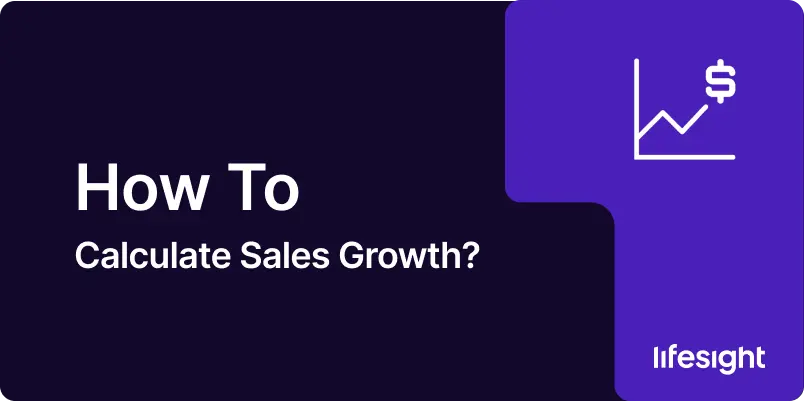
In the dynamic world of marketing and advertising, few metrics are as crucial as sales growth. It’s the north star that guides strategies, informs budgets, and ultimately determines the success of your campaigns. But how exactly do you calculate sales growth, and more importantly, how can you use this information to supercharge your marketing efforts? This guide will walk you through everything you need to know about calculating and leveraging sales growth in your marketing and advertising campaigns.
What is Sales Growth?
Before we dive into the calculations, let’s define what we mean by sales growth:
Sales growth is the increase (or decrease) in a company’s sales between two time periods, expressed as a percentage. It’s a key indicator of a company’s performance and the effectiveness of its marketing and sales strategies.
For marketers and advertisers, understanding sales growth is crucial because it:
- Measures the effectiveness of marketing campaigns
- Helps in setting realistic sales targets
- Guides budget allocation for future marketing initiatives
- Identifies trends and seasonality in sales performance
- Provides a benchmark for comparing performance against competitors
The Basic Formula for Sales Growth
The formula for calculating sales growth is straightforward:
Sales Growth = [(Current Period Sales – Previous Period Sales) / Previous Period Sales] x 100
This gives you the percentage increase (or decrease) in sales between two periods.
Step-by-Step Guide to Calculating Sales Growth
Let’s break down the process of calculating sales growth with a practical example relevant to marketing and advertising professionals.
Step 1: Determine Your Time Periods
First, decide on the periods you want to compare. This could be:
- Month-over-month
- Quarter-over-quarter
- Year-over-year
For this example, let’s use quarterly data.
Step 2: Gather Your Sales Data
You’ll need the total sales figures for both periods:
- Current period sales
- Previous period sales
Let’s say you’re analyzing the performance of a digital marketing agency:
- Q2 2023 Sales (Current Period): $500,000
- Q1 2023 Sales (Previous Period): $400,000
Step 3: Apply the Sales Growth Formula
Now, let’s plug these numbers into our formula:
Sales Growth = [($500,000 – $400,000) / $400,000] x 100 = ($100,000 / $400,000) x 100 = 0.25 x 100 = 25%
This means your agency experienced a 25% sales growth from Q1 to Q2 2023.
Interpreting Sales Growth in Marketing Contexts
Now that we’ve calculated sales growth, what does this mean for your marketing and advertising strategies?
- Campaign Effectiveness: A significant increase in sales growth following a new campaign suggests its effectiveness.
- Seasonal Trends: Comparing sales growth across different quarters can reveal seasonal patterns in your business.
- Market Penetration: Consistent positive sales growth might indicate successful market penetration strategies.
- Product Performance: Calculating sales growth for individual products or services can highlight which offerings are driving overall growth.
- ROI Assessment: By comparing sales growth to marketing spend, you can assess the return on investment of your marketing efforts.
Real-World Applications in Marketing and Advertising
Let’s explore some specific scenarios where calculating sales growth can inform your marketing decisions:
1. Evaluating a New Product Launch
Scenario: Your company has just launched a new product line with a comprehensive marketing campaign.
Q3 2022 Sales (before launch): $1,000,000 Q4 2022 Sales (after launch): $1,300,000
Sales Growth = [($1,300,000 – $1,000,000) / $1,000,000] x 100 = 30%
The 30% sales growth suggests that the product launch and associated marketing campaign were successful. This insight can guide future product launches and marketing strategies.
2. Assessing the Impact of a Rebranding Effort
Scenario: Your agency has undergone a rebranding process, including a new visual identity and messaging strategy.
Year 1 Sales (before rebranding): $5,000,000 Year 2 Sales (after rebranding): $5,750,000
Sales Growth = [($5,750,000 – $5,000,000) / $5,000,000] x 100 = 15%
The 15% year-over-year sales growth indicates that the rebranding effort has positively impacted sales. This could justify the investment in rebranding and inform future brand development strategies.
3. Comparing Performance Across Different Marketing Channels
Scenario: You want to compare the effectiveness of two different marketing channels: social media advertising and email marketing.
Social Media Advertising:
- Last Month Sales: $50,000
- This Month Sales: $65,000
- Sales Growth: [($65,000 – $50,000) / $50,000] x 100 = 30%
Email Marketing:
- Last Month Sales: $40,000
- This Month Sales: $48,000
- Sales Growth: [($48,000 – $40,000) / $40,000] x 100 = 20%
The higher sales growth in social media advertising (30% vs. 20%) suggests it might be more effective, potentially warranting increased investment in this channel.
Advanced Considerations in Sales Growth Calculations
As you become more proficient with basic sales growth calculations, consider these advanced concepts:
1. Compound Annual Growth Rate (CAGR)
When looking at sales growth over multiple years, CAGR provides a smoother, average growth rate:
CAGR = (Ending Value / Beginning Value)^(1/n) – 1
Where n is the number of years.
2. Segmented Sales Growth
Calculate sales growth for different segments of your business:
- By product or service line
- By customer demographic
- By geographic region
This granular approach can reveal hidden trends and opportunities.
3. Adjusted Sales Growth
In some cases, you might want to adjust for factors like:
- Inflation
- Changes in number of business days
- Acquisitions or divestitures
This provides a more accurate picture of organic growth.
4. Rolling Sales Growth
Instead of fixed periods, use a rolling time frame (e.g., last 12 months vs. previous 12 months) to smooth out short-term fluctuations.
Common Pitfalls to Avoid
When working with sales growth in marketing contexts, watch out for these common mistakes:
- Ignoring Context: A high growth rate might look impressive but could be misleading if coming from a small base.
- Overlooking Seasonality: Comparing a peak season to an off-season can give a distorted view of growth.
- Focusing Only on Percentage: Remember to consider absolute dollar amounts alongside percentages.
- Neglecting External Factors: Economic conditions, competitive actions, or regulatory changes can impact sales growth.
- Short-Term Thinking: Don’t let short-term sales growth drive decisions that could harm long-term brand equity.
Tools for Sales Growth Analysis
Several tools can assist you in calculating and analyzing sales growth:
- Spreadsheet Software: Excel or Google Sheets are excellent for basic calculations and creating visual representations of your data.
- Business Intelligence Platforms: Tools like Tableau, Power BI, or Looker can help you create dynamic dashboards to track sales growth across different dimensions.
- CRM Systems: Platforms like Salesforce or HubSpot often have built-in reporting features for sales metrics.
- Marketing Analytics Tools: Solutions like Google Analytics or Adobe Analytics can help you tie sales growth to specific marketing channels or campaigns.
- Financial Analysis Software: Tools like QuickBooks or Xero can provide sales data and basic growth calculations.
Leveraging Sales Growth in Your Marketing Strategy
Understanding and effectively using sales growth calculations can significantly enhance your marketing and advertising decision-making processes. Here’s how you can leverage this metric:
- Goal Setting: Use historical sales growth data to set realistic and ambitious targets for your marketing campaigns.
- Budget Allocation: Invest more in marketing channels or campaigns that have driven higher sales growth.
- Performance Evaluation: Use sales growth as a key metric in evaluating the success of marketing initiatives.
- Forecasting: Utilize sales growth trends to forecast future sales and plan marketing activities accordingly.
- Competitive Analysis: Compare your sales growth to industry benchmarks to identify areas for improvement or competitive advantages.
- Product Development: Use sales growth data by product line to inform new product development or improvements.
- Market Expansion: Identify high-growth markets or segments that might be ripe for expanded marketing efforts.
Conclusion: Making Sales Growth Work for Your Marketing Strategy
Sales growth is more than just a number—it’s a story of your company’s success and a roadmap for future growth. By mastering the calculation and interpretation of sales growth, you arm yourself with a powerful tool to drive your marketing and advertising strategies.
Remember, while sales growth is a critical metric, it should be used in conjunction with other KPIs like customer acquisition cost, customer lifetime value, and overall profitability. The most successful marketing strategies take a holistic view, balancing short-term sales growth with long-term brand building and customer relationships.
As you continue to refine your approach to calculating and applying sales growth insights, you’ll develop a more nuanced understanding of your business, your customers, and the impact of your marketing efforts. This knowledge will empower you to create more targeted, effective marketing campaigns that not only drive immediate sales but also set the stage for sustainable, long-term growth.
So, the next time you’re planning a marketing campaign, evaluating channel performance, or making a case for increased marketing budget, remember to leverage your sales growth data. It might just be the key to unlocking your next big marketing breakthrough!
Free essential resources for success
Discover more from Lifesight
















